Growing Peas at Home in Containers & Pots
June 11th, 2021 | Categories
Growing peas at home from seed in containers and pots is an easy way to have a bountiful supply of fresh peas without taking up too much space or allocated a dedicated portion of the garden. Growing peas in containers and pots is a solution for anyone who might not have a garden but still wants to grow their own on a rooftop, patio area, or balcony for example. Containers offer versatility and peas do well in containers too so they will not hold you back at all, not will they have to be given huge amounts of extra attention. They don’t require a lot of space either and many varieties do extremely well when grown in containers and pots.
Peas are without a doubt a staple on our dinner plates. From lovely garden peas to petit pois, to big marrowfat peas, we mint them, we mush them… the list goes on and on. And on. The average person in the UK allegedly consumes more than 10,000 of them each and every year too. While technically a fruit, we eat them like vegetables, similar to tomatoes and peppers. New and experienced gardeners up and down the country grow peas because they are easy to grow, some varieties need little to no support, and they don’t need lots of space meaning they can grow well in containers. Additionally, peas grown fresh are an absolute delight. Gardeners swear by the sweet taste from peas that have been picked fresh from the vine the same day.
Another reason why gardeners love to grow peas is their preference for cooler conditions, meaning they do well in our climate (there are some things our weather is good for), and there are varieties of peas that produce crops earlier in the year too meaning they can be grown and enjoyed sooner. This easy-to-follow guide will help beginners and experienced gardeners alike to grow peas in pots and containers at home. We’ll take you through the process from pea seed all the way to harvest and tell you more you’ll need to ensure successful container grown crops throughout the growing season. If you have a garden and are set in growing in the ground, then please refer to our other guide on growing peas at home here. Let’s get started.
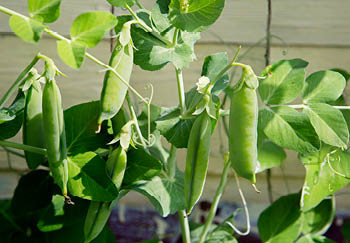
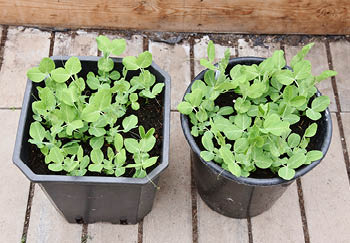
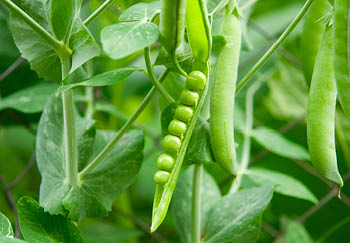
Why Grow Peas at Home in Containers?
Peas are incredibly popular, and they do well in our British climate, so that makes them a great (even forgiving) choice for beginner gardeners or those new to growing their own vegetables. Container grown peas also do quite well which means those people who may only have small gardens or no garden at all can still produce a successful crop to enjoy. They don’t need a lot of effort or attention and won’t impact on your usual day-to-day. Also, the flavour of fresh peas compared to supermarket peas is supremely better. Peas grown and ate fresh have a much better, super-sweet flavour and are also much more tender. Forget about frozen or tinned peas supermarket peas, nothing compares. Take our word for it.
Supermarket peas, like all fruit and veg, are grown for longevity and they are not fresh even by the time they reach the supermarket shelf, and that’s before they are purchased. Growing your own means you will get more of the good nutrients. Peas are a great source for plant-based protein, they are high in heart-friendly minerals like calcium, magnesium, potassium and are also rich in vitamin C, as well as phytonutrients including carotenoids and flavanols which are protect our hearts and support cardiovascular function. This is a superfood that should be on your plate fresh!
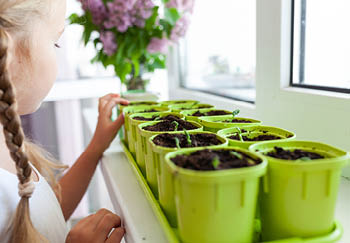

What Variety of Peas Should You Grow in Containers?
Before you plant, you need to consider what type or types of peas you would like to grow at home in containers. Most varieties will be fine, but there are some that do better than others in containers. You also have to consider how much space you have. Containers do make planting versatile, and peas don’t take up much space, but when some pea plants can grow to over 2 metres in height that will need additional supports, then you need to think about where that fits in.
So, consider what you want and then do your research on what peas you wish to grow. Maybe it’s all about flavour or size, or maybe you want a very low-maintenance variety that needs the least amount of effort during growing. Whatever the variety it will be pea seeds you need, as these are especially for growing lovely pea plants. You can get these from any good garden centre. However, there’s a few things worth noting first so read ahead before starting anything.
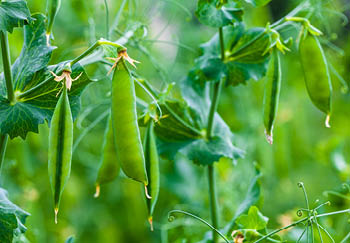

Earlies vs Maincrop Peas
Peas are classified as being either earlies or maincrops. Early varieties of peas are ready to harvest much sooner than maincrops, about 12 weeks generally. Maincrop varieties however are in the ground longer. Up to 16 weeks generally. In terms of harvesting, Maincrops are typically harvested in late summer or early autumn. Early varieties are typically harvested from early to midsummer and are further divided into first earlies and second earlies.
First early varieties are of course first to harvest, while second earlies follow on a few weeks later, around 14 weeks in total. Whatever variety you wish to grow just be sure of their specific type, when to sow, when to harvest, and any individual needs or characteristics they may have. If your containers are being grown indoors, you may be able to plant sooner and therefore the
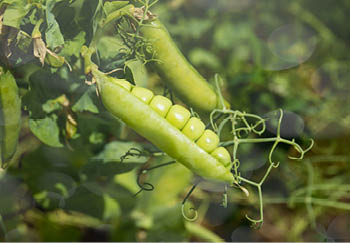
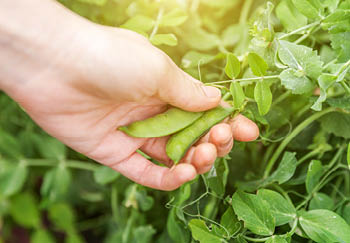
Other Groups of Peas
Besides earlies and maincrop peas, you also have some other groups of peas. Round varieties of peas are smooth when dried and are hardier than wrinkled varieties. Wrinkled varieties will produce heavier crops but are not as hardy as round varieties of peas. Also, all round varieties of peas are dwarf varieties and wrinkled varieties will climb with vine-like stems, which also means they need supported in some way. Some dwarf varieties will grow large enough to need some support too, but not a requirement in every case.
They are all grown pretty much the same way barring a few considerations, so just be aware of the variety of peas you are choosing and any individual characteristics or needs. Having said that though, dwarf varieties may be better for growing at home in containers or pots. Climbers can grow to well over 2 metres tall. Dwarf varieties might only grow to be 2 or 3 feet tall by comparison, and they will still produce lots of lovely peas, and they dominate your indoors space, patio or balcony. Something to consider.

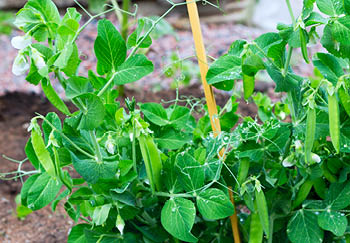
Varieties to try
If you thought garden peas, petit pois, and marrowfat (among others) are all just single varieties and that’s it, then you’d be wrong, albeit forgiven. It is all you see in supermarkets. But this hides the number of pea varieties that are actually grown quite commonly. The Romans alone grew almost 40 varieties of peas. We’ve become a nation of efficiency rather than variety, and that’s no bad thing, but the differences in flavour and freshness make it worth trying to grow your own alone. This list below is just a small selection of the many varieties of pea you can choose.
Alderman (maincrop, climbing)
This is also known as Victorian Colossal Climbing for good reason. It will produce a mass of peas for you and they taste amazing, possibly one of the best for flavour.
Early Onward (early, climbing)
One of the most reliable varieties of peas, producing a good crop even in years with worse than usual conditions. Slightly larger than average pods with an average of 7 peas in each pod.
Hurst Green Shaft (maincrop, dwarf)
A popular maincrop variety, the Hurst Green Shaft is generally a heavy cropper producing pods with at least 10 peas each in them. They have a great sweet flavour and are also resistant to disease.
Kelvedon Wonder (early, dwarf)
This is quite a compact dwarf variety, that produces heavy crops of two-pointed pea pods each containing up to 8 peas. It is quite resistant to disease like the Hurst Green Shaft.
Terrain (maincrop)
If you want lots of peas, opt for the Terrain variety which is generally extremely high yielding. They will literally produce huge amounts of pods containing up to 8 deliciously sweet peas. They are disease resistant too.
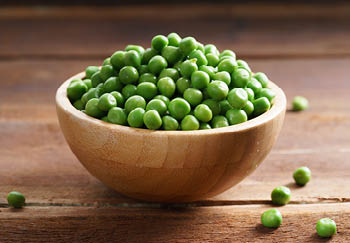

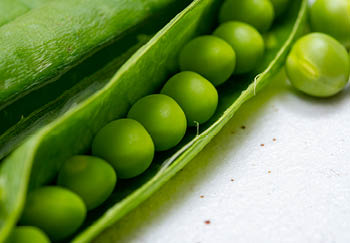
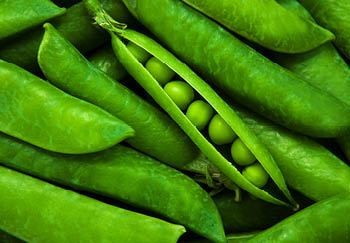
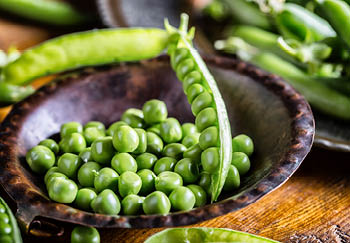
General Growing/Harvesting Timescale for Peas
When it comes to sowing and planting pea seeds you will generally sow in February or March depending on the conditions. Since you are using containers, you can start off growing indoors, which in turn means you will be able to start in February because indoor conditions will be better generally. Then then you can move your pots outdoors when the weather outside improves. Then depending on the variety, they will be ready for harvest sometime from June, possibly even May, through to October. Some varieties will produce over the entire season, whereas others you will have to sow again which you can do up until early July usually.
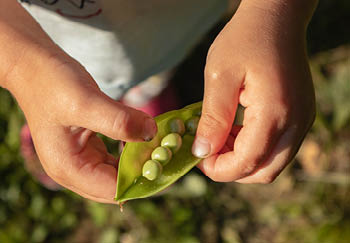
How to Start Growing Peas in Containers at Home
Now you know more about peas you’re ready to get started growing your own peas in containers or pots at home. It pays to know what to do in advance so read through our guide fully. Then when you’re ready to go, you can get started.
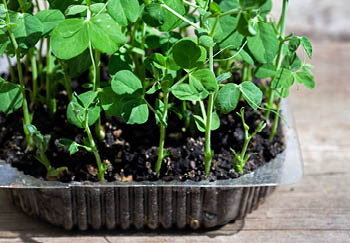
What You Will Need
To get started growing peas in containers or pots at home you’ll need to gather the following:
Pea Seeds
Purchase the pea seed varieties you wish to grow in your containers.
Hand Fork
A fork helps to loosen clumps of soil and compost.
Hand Trowel
A hand trowel is so versatile for digging, smoothing, and applying compost or soil. Like a mini shovel.
Containers or Pots
You’ll need containers of pots to grow your peas in. Consider how many plants you would like to grow. For instance, a 20cm pot with a good depth could probably allow about three to five pea seeds to grow. So maybe you’d like two or three pots to have a bountiful harvest and so you can grow different varieties? Ensure the containers or pots have good drainage as waterlogged soil will affect their grow and probably see them fail.
Compost
A good quality multi-purpose vegetable compost will do the trick and provide lots of nutrients while your seeds and plants grow.
Fertiliser
Because they are container grown, there will be less nutrients available than there would be in the ground, so a good quality high-potash fertiliser will really help. Any vegetable or tomato fertiliser should do the job nicely.
The Right Spot
Peas need a good amount of water when they start to flower to really allow their pods to swell. Up until this point though watering should be controlled, and the plants should be protected until the seedlings are a bit tougher to handle the outside elements (if you are going to move the containers outside that is). They also like a sunny spot so again, consider this in your placement.

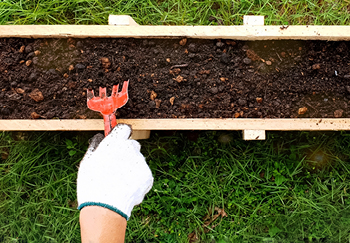
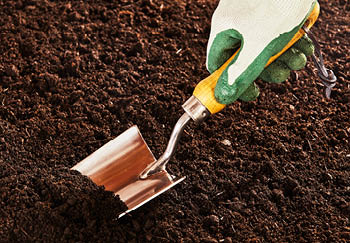
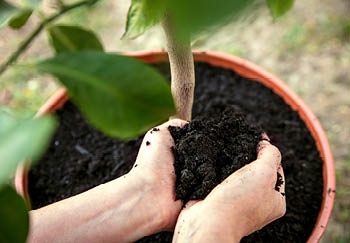
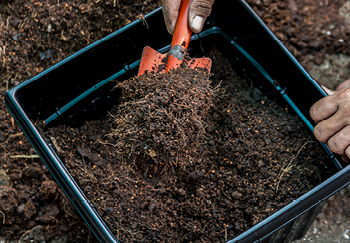
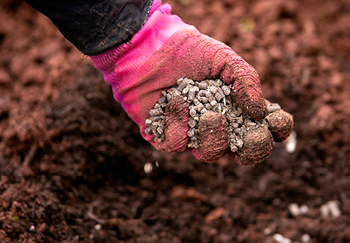

Sowing Your Pea Seeds in Containers
So, by now you have got your tools handy, your pea seeds, the containers/pots and you have chosen your spot or spots. Nice! So, the first thing you will do is fill your containers with the compost right to the top and place your pea seeds in gently giving them a good amount of space between, so they are not crowding each other. Try to find a balance between the number of peas you can grow while giving them enough space to grow. If it looks too crowded it probably is. Try about 5cm apart to start off. Once done, cover with a thin layer of compost and give them a water.
Please note, peas do not like to be sown into cold or wet soil, which would be a problem outdoors. However, we assume everyone reading will start off indoors, at least in the beginning. One they are established and when the frosts have passed, they can be moved outdoors to a balcony, roof, or patio area. On the other hand, though, if you want to do the whole thing indoors, this shouldn’t be a problem.
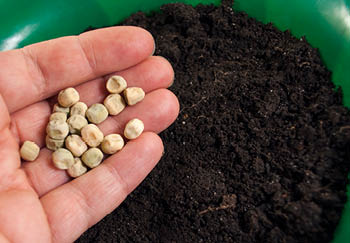
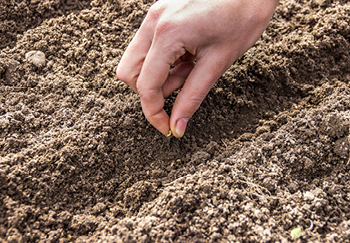
Growing
Your pea seedlings should appear within two weeks of planting. Water the plants after this period and when you see them start to flower. If you opted for climbing pea varieties, they will need supports in place while they are still young to help them scramble up and grow. This support can come in the form of a trellis, bamboo canes, wire, and netting. If you search online for ideas, you’ll find plenty of photos and guides to draw inspiration from for your containers. If you opted for smaller dwarf varieties then chances are they won’t need any supports but will probably appreciate it! This can be done with pea netting or pea sticks. Not all will need support, but it will probably help their development, so they are not sagging over themselves.
After flowering, the plants need sufficient water for the pods to swell. Check the soil moisture regularly and water if needed without overloading them. Because you are growing in containers, they will need to be watered consistently and regularly, more so than growing outdoors in the ground where moisture can be drawn up from the soil. If you are growing entirely indoors you may need to water more frequently still depending on the ambient temperatures, and obviously there’s no rainfall either. After the flowering stage also feed weekly with your fertiliser to ensure they have a plentiful supply of nutrients to produce lots of amazing peas in your containers.
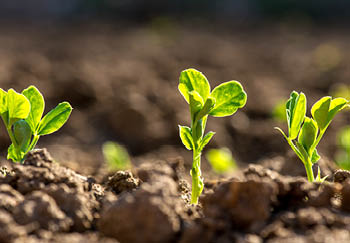
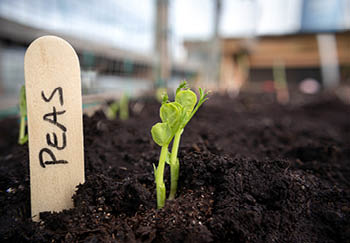
Harvesting Your Container-Grown Peas
Depending on your variety of peas and the type they are, they’ll be ready to harvest when the pods are visibly swollen with peas. Keep a note in your diary of how long your chosen variety should take to be ready (remember if they are early or maincrop) and then harvest around this time. Top tip: pick the pods from the bottom of the plant upwards, as generally the lower the pod then the more mature they are. Try to be gentle and avoid damaging the plant itself as many will continue to produce for a while so long as the care and conditions are right. Pick regularly otherwise new pods won’t form. Once harvested from your containers or pots, consume promptly for the best flavour. They can be eaten raw, and they will be utterly delicious and sweet, nothing like store bought peas. You might have to stop yourself from eating them all!
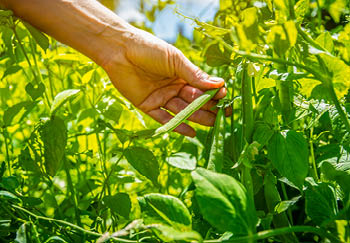
Storing Your Peas
Peas really are best used or ate soon after they are picked but if you like you can store them in the fridge for about a week or freeze them.
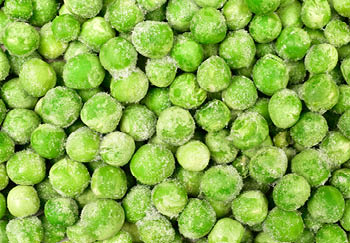
Common Problems to Watch Out For
Like all things grown in the garden at home, there are few things to watch out for that can affect your pea crop. Have a read through this list so you are prepared and know what to watch out for so you can act quickly should the need arise:
Birds
Birds can take the leaves off the plants leaving them bare. Using netting can stop these pests from getting to them.
Pea Moth
Pea moths will lay their eggs on pea flowers. The larvae then live in the pods, feeding on the developing peas growing into caterpillars. Grow your crops under insect-proof mesh to prevent this from happening. Though early spring and early summer sowings are less affected by this.
Powdery Mildew
This is a fungal disease that appears as a white mildew on pea plants. If it takes hold, it can stunt growth and cause leaves to shrivel and die. Drought-stressed plants are more susceptible to this disease so ensure they are consistently watered.
Watering
After flowering, peas need a lot of water without being waterlogged to allow their pods to swell up. Growing in containers means they are prone to drought because there’s no soil to draw moisture from, or rainwater if grown completely indoors. Check the moisture of the soil regularly.
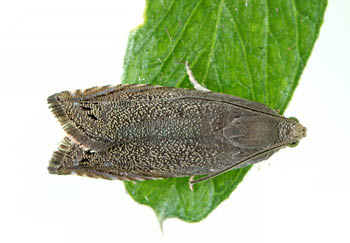

Home Grown Peas from Containers
And there you have it, your own plentiful crop of peas grown at home in containers and pots. Did you think it would be this easy or that you could grow so many? Containers offer a lot of versatility and mean that anyone, not just those with a large enough garden can get to growing their own fruit and veggies at home. We advise you to try some of the peas raw as soon as they are ready for picking, they’ll be delicious!

Useful Links
- Shop Online for Pea Seeds
- Grow Peas from Seed to Harvest (Article)
- Growing Onions from Seed to Harvest (Article)
- Growing Peppers from Seed to Harvest (Article)
- Growing Potatoes from Planting to Harvest (Article)
- Growing Chillies from Seed to Harvest (Article)
- Guide to Growing Tomatoes in Pots (Article)
- Grow Your Own Strawberries (Article)






